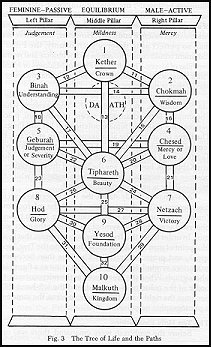Justice and the Kabbalah regarding the Spirit of Prayer

The Tree of Life, commonly called the Kabbalah, associates Mercy with Judgement, as they are opposite each other : Mercy is the 4th sefirot and Geburah or Judgement is 5. These are two of the divine attributes of Yahweh.
The Hebrew Alpha-bet reads right to left, and so does the tree. The left side where Judgement (Geburah) resides is Feminine, while the Right is Active and Masculine (Chesed #4). This means that even numbers are active while uneven numbers are unstable and passive – like the atom they receive instructions.
Then there is the Middle Pillar or the spine of tree,. If one reads up Malkuth #10 to #1 Kether, as you ascend the tree, you must be one of the Kingdom i.e. a believer. Nothing happens without that first step towards God. From there, you need solid foundation (yesod) in His teachings and ways. Tipareth the central sefirot, typically translated as Beauty, is not physical beauty, but a total equilibrium, absolute balance between the left and right arms of the Tree.
As we continue on with the Spirit of Prayer, keep in the mind the picture of the Tree and how Law describes the fall. It is an intertwining of God himself and his teaching, esoteric philosophy, Jewish mysticism and Christian religious reflecting on the Four divine attributes of Malkuth, Yesod, Tipareth and Kether that together help man balance himself between illusion and the real (mind). They are the Golden Mean man should be striving towards in this life.
The word Justice, shows up on the tree typically as HOD or splendor. It too is often misunderstood as the splendor of God’s bounty, but the noun splendor in English means “the exercise of authority in vindication of right by assigning reward or punishment,”
It came from the Old French ” justise” and probably was imported during the Norman conquest. The Old Fr. word itself is from the Latin . justitia “righteousness, equity,” and from the idea justus “upright, just” (see the word just (adj.)). The O. Fr. word had widespread senses, including”uprightness, equity, vindication of right, court of justice, judge. How that relates to HOD or Splendour is very Talmudic: the Glory of the Law of God or Natural Law.
When Justice was first used in English c.1200 it was just as a title for a judicial officer, or judicial administrator or as positive law and while that seems that there are no heavenly implications, one must remember the biblicial and esoteric statute "as above, so below" so that the positive law was supposed to reflect Natural Law and not be a perversion of it.
Mercian was a language spoken in the Anglo-Saxon kingdom of Mercia (roughly the Midlands of England). Together with Northumbrian, it was one of the two Anglian dialects of Britain before the Norman Conquest and the Kingdom of Mercia at its greatest extent (7th to 9th centuries) is shown in green, with the original core area (6th century) given a darker tint.
In the Mercian hymns by Geoffrey Hill, the Latin word justitia is glossed into Old English as rehtwisnisse or right witness -- hence we "swear" with our right hand on the Bible that we are telling the truth or damning our immortal soul if we are lying. Of course in polygot society that does have problems as Moslems are allowed to lie if it will further the cause of Islam.
Latin does not carry over per se, the Greek idea, that Justice is blind but adds a nuance that Justice is “weighty” referring back to the Egyptian idea of Ma’at’s weighing a man’s heart at death to see how far it had fallen from the original ideal.
English does do a lovely job of marrying the two ideas into a new whole.
English does do a lovely job of marrying the two ideas into a new whole.
Online Etymology Dictionary, © 2010 Douglas Harper

No comments:
Post a Comment